Thank you for
Page 26
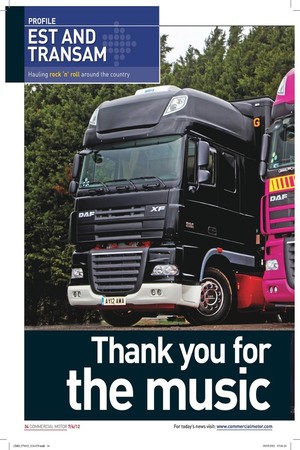
Page 27
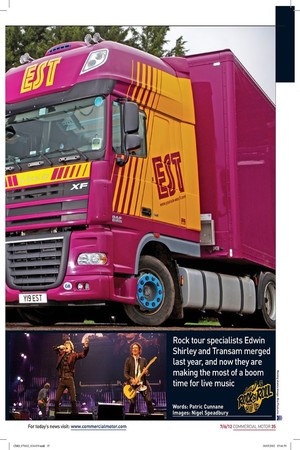
Page 28
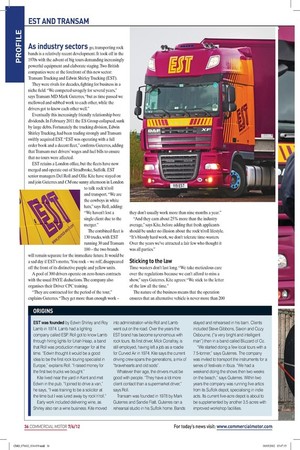
Page 31
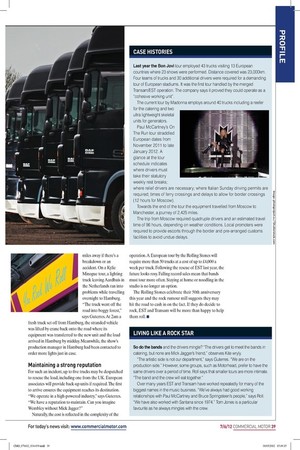
Page 30
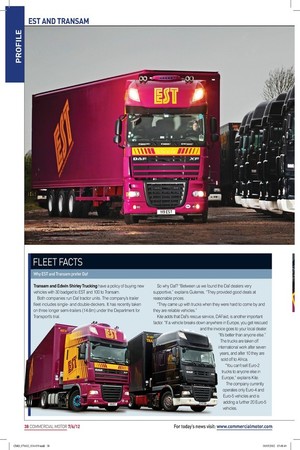
If you've noticed an error in this article please click here to report it so we can fix it.
he music
Rock tour specialists Edwin Shirley and Transam merged last year, and now they are making the most of a boom time for live music
Words: Patric Cunnane Images: Nigel Speadbury As industry sectors go, transporting rock bands is a relatively recent development. It took off in the 1970s with the advent of big tours demanding increasingly powerful equipment and elaborate staging. Two British companies were at the forefront of this new sector: Transam Trucking and Edwin Shirley Trucking (EST).
They were rivals for decades, fighting for business in a niche field. “We competed savagely for several years,” says Transam MD Mark Guterres, “but as time passed we mellowed and subbed work to each other, while the drivers got to know each other well.” Eventually this increasingly friendly relationship bore dividends. In February 2011 the ES Group collapsed, sunk by large debts. Fortunately the trucking division, Edwin Shirley Trucking, had been trading strongly and Transam swiftly acquired EST. “EST was operating with a full order book and a decent fleet,” confirms Guterres, adding that Transam met drivers’ wages and fuel bills to ensure that no tours were affected.
EST retains a London office, but the fleets have now merged and operate out of Stradbroke, Suffolk. EST senior managers Del Roll and Ollie Kite have stayed on and join Guterres and CM one sunny afternoon in London to talk rock‘n’roll and transport. “We are the cowboys in white hats,” says Roll, adding: “We haven’t lost a single client due to the merger.” The combined fleet is 130 trucks, with EST running 30 and Transam 100 – the two brands will remain separate for the immediate future. It would be a sad day if EST’s motto, ‘You rock – we roll’, disappeared off the front of its distinctive purple and yellow units.
A pool of 300 drivers operate on zero-hours contracts with the usual PAYE deductions. The company also organises their Driver CPC training.
“They are contracted for the period of the tour,” explains Guterres. “They get more than enough work – they don’t usually work more than nine months a year.” “And they earn about 25% more than the industry average,” says Kite, before adding that fresh applicants should be under no illusion about the rock‘n’roll lifestyle. “It’s bloody hard work, we don’t tolerate time-wasters. Over the years we’ve attracted a fair few who thought it was all parties.”
Sticking to the law
Time-wasters don’t last long. “We take meticulous care over the regulations because we can’t afford to miss a show,” says Guterres. Kite agrees: “We stick to the letter of the law all the time.” The nature of the business means that the operation ensures that an alternative vehicle is never more than 200 miles away if there’s a breakdown or an accident. On a Kylie Minogue tour, a lighting truck leaving Aardhuis in the Netherlands ran into problems while travelling overnight to Hamburg. “The truck went off the road into boggy forest,” says Guterres. At 2am a fresh truck set off from Hamburg, the stranded vehicle was lifted by crane back onto the road where its equipment was transferred to the new unit and the load arrived in Hamburg by midday. Meanwhile, the show’s production manager in Hamburg had been contacted to order more lights just in case.
Maintaining a strong reputation
For such an incident, up to five trucks may be despatched to rescue the load, including one from the UK. European associates will provide back-up units if required. The first to arrive ensures the equipment reaches its destination. “We operate in a high-powered industry,” says Guterres. “We have a reputation to maintain. Can you imagine Wembley without Mick Jagger?” Naturally, the cost is reflected in the complexity of the operation. A European tour by the Rolling Stones will require more than 50 trucks at a cost of up to £4,000 a week per truck. Following the rescue of EST last year, the future looks rosy. Falling record sales mean that bands must tour more often. Staying at home or noodling in the studio is no longer an option.
The Rolling Stones celebrate their 50th anniversary this year and the rock rumour mill suggests they may hit the road to cash in on the fact. If they do decide to rock, EST and Transam will be more than happy to help them roll. ■
ORIGINS
EST was founded by Edwin Shirley and Roy Lamb in 1974. Lamb had a lighting company called ESP. Roll got to know Lamb through hiring lights for Uriah Heap, a band that Roll was production manager for at the time. “Edwin thought it would be a good idea to be the first rock touring specialist in Europe,” explains Roll. “I raised money for the first two trucks we bought.” Kite lived near the yard in Kent and met Edwin in the pub. “I joined to drive a van,” he says, “I was training to be a solicitor at the time but I was lured away by rock‘n’roll.” Early work included delivering wine, as Shirley also ran a wine business. Kite moved into administration while Roll and Lamb went out on the road. Over the years the EST brand has become synonomous with rock tours. Its first driver, Mick Conafray, is still employed, having left a job as a roadie for Curved Air in 1974. Kite says the current driving crew spans the generations, a mix of “bravehearts and old sods”.
Whatever their age, the drivers must be good with people. “They have a lot more client contact than a supermarket driver,” says Roll.
Transam was founded in 1978 by Mark Guterres and Sandie Flatt. Guterres ran a rehearsal studio in his Suffolk home. Bands stayed and rehearsed in his barn. Clients included Steve Gibbons, Saxon and Ozzy Osbourne, (“a very bright and intelligent man”) then in a band called Blizzard of Oz.
“We started doing a few local tours with a 7.5-tonner,” says Guterres. The company was invited to transport the instruments for a series of festivals in Ibiza. “We had a weekend doing the shows then two weeks on the beach,” says Guterres. Within two years the company was running five artics from its Suffolk depot, specialising in indie acts. Its current five-acre depot is about to be supplemented by another 3.5 acres with improved workshop facilities.
FLEET FACTS
Why EST and Transam prefer Daf Transam and Edwin Shirley Trucking have a policy of buying new vehicles with 30 badged to EST and 100 to Transam.
Both companies run Daf tractor units. The company’s trailer fleet includes singleand double-deckers. It has recently taken on three longer semi-trailers (14.6m) under the Department for Transport’s trial. So why Daf? “Between us we found the Daf dealers very supportive,” explains Guterres. “They provided good deals at reasonable prices.
“They came up with trucks when they were hard to come by and they are reliable vehicles.” Kite adds that Daf’s rescue service, DAFaid, is another important factor. “If a vehicle breaks down anywhere in Europe, you get rescued and the invoice goes to your local dealer. “It’s better than anyone else.” The trucks are taken off international work after seven years, and after 10 they are sold off to Africa.
“You can’t sell Euro-2 trucks to anyone else in Europe,” explains Kite.
The company currently operates only Euro-4 and Euro-5 vehicles and is adding a further 20 Euro-5 vehicles.
CASE HISTORIES
Last year the Bon Jovi tour employed 43 trucks visiting 13 European countries where 23 shows were performed. Distance covered was 23,000km. Four teams of trucks and 30 additional drivers were required for a demanding tour of European stadiums. It was the first tour handled by the merged Transam/EST operation. The company says it proved they could operate as a “cohesive working unit”.
The current tour by Madonna employs around 40 trucks including a reefer for the catering and two ultra lightweight skeletal units for generators.
Paul McCartney’s On The Run tour straddled European dates from November 2011 to late January 2012. A glance at the tour schedule indicates where drivers must take their statutory weekly rest breaks; where relief drivers are necessary; where Italian Sunday driving permits are required; times of ferry crossings and delays to allow for border crossings (12 hours for Moscow).
Towards the end of the tour the equipment travelled from Moscow to Manchester, a journey of 2,425 miles.
The trip from Moscow required quadruple drivers and an estimated travel time of 96 hours, depending on weather conditions. Local promoters were required to provide escorts through the border and pre-arranged customs facilities to avoid undue delays.
LIVING LIKE A ROCK STAR
So do the bands and the drivers mingle? “The drivers get to meet the bands in catering, but none are Mick Jagger’s friend,” observes Kite wryly.
“The artistic side is not our department,” says Guterres. “We are on the production side.” However, some groups, such as Motorhead, prefer to have the same drivers over a period of time. Roll says that smaller tours are more intimate. “The band and the crew will eat together.” Over many years EST and Transam have worked repeatedly for many of the biggest names in the music business. “We’ve always had good working relationships with Paul McCartney and Bruce Springsteen’s people,” says Roll. “We have also worked with Santana since 1974.” Tom Jones is a particular favourite as he always mingles with the crew.











































